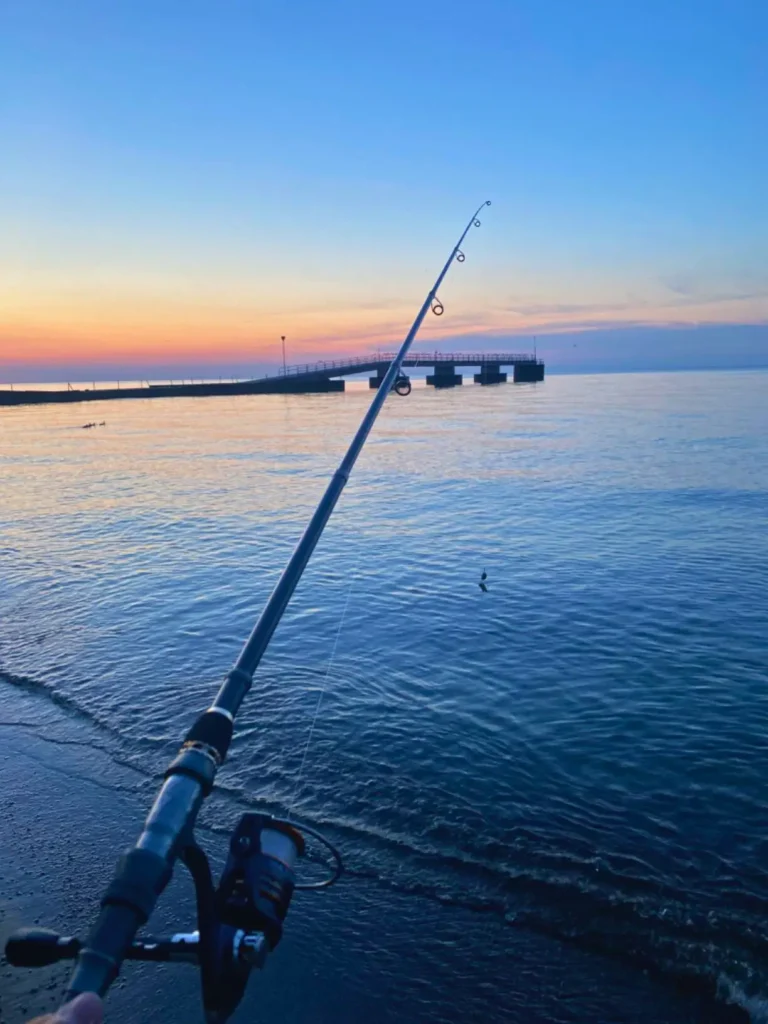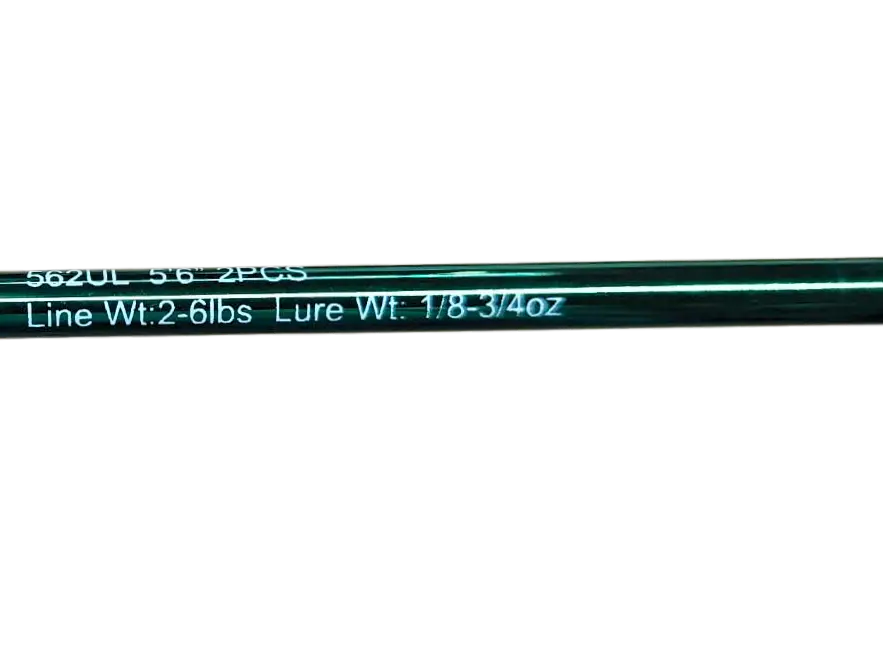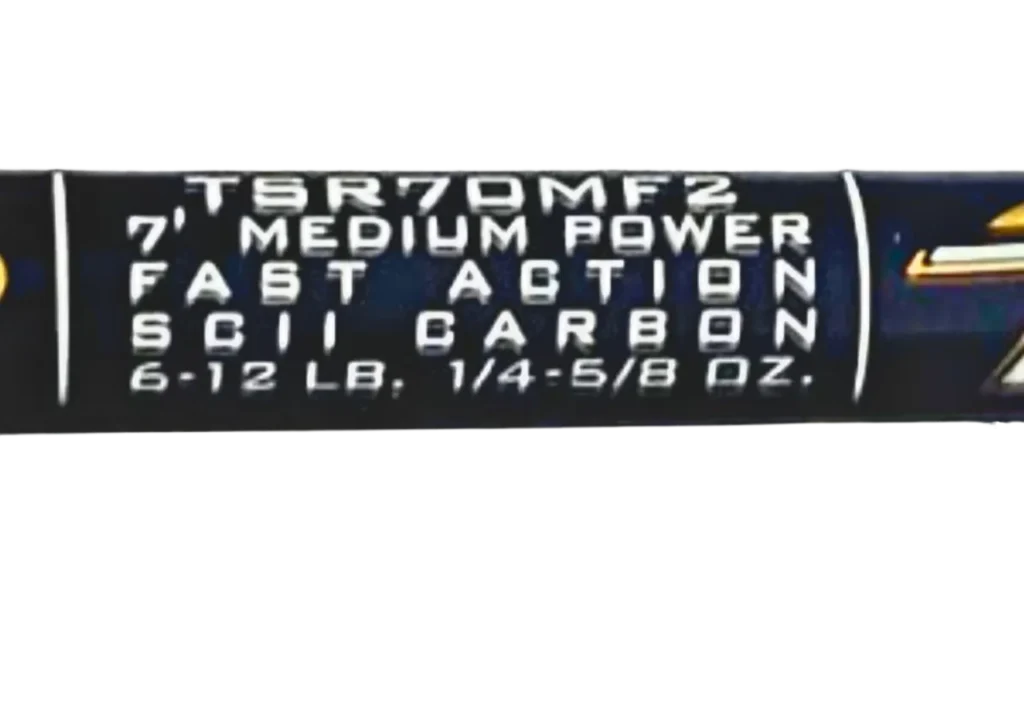Are you tired of struggling with the correct weight of your fishing rod? Look no further! Our article provides the common problems that anglers face when selecting the right weight fishing rod. We’ve gathered valuable insights from fishing enthusiasts and experts to help you understand the importance of matching the rod weight with your preferred lure and fishing line. Discover the secrets to achieving optimal balance and control in your fishing endeavors. Take advantage of this must-read article that will revolutionize your fishing experience.

What is rod weight:
The weight of a fishing rod refers to two terms. ” the physical weight of the rod” or ”the weight designated for a specific rod, also called weight rating”.
Physical weight of rod:
The physical weight of the fishing rods is direct to the actual weight of the rod. This weight is usually measured in grams or ounces.
The physical weight of the fishing rod includes the following;
- Material of which the rod is made (fiberglass, graphite, or other composites)
- The weight of the reel, guides, and handle
- Based on the length of the fishing rod
However, lighter-weight rods are preferred by anglers because of their sensitivity and ease of use, while heavier rods are perfect for targeting larger species of fish.
Weight rating of fishing rod:
The weight rating of the fishing rods, also called the power rating, ranges from ultra-light to heavier. This rating indicates the point of weight where the rod bends.
For example, heavier rods are more challenging to bend than lighter rods.
Heavier rods are used to catch larger fish, while light rods are perfect for smaller fish.
Moreover, perfect fishing is not only based on buying the correct weight of fishing rod according to the size of the target species but also on considering other factors such as lure and line weight and the size of the reel.
A series of numbers and letters are printed on the rod, making it convenient for anglers to know about the weight rating of a fishing rod.
What do numbers and letters print on the fishing rod indicate?

There are specific numbers and letters written on a fishing rod. The set of these numbers and letters indicates the specifications of the rod.
What are these numbers for? So, let’s elaborate on the serial code of the image.
Here:
- 5’6” refers to the length of the fishing rod
- UL refers to power (ultra-light)
- 2PC refers that the rod consists of 2 pieces (which means it can be separated into two sections, making it easier for storage and transportation)
- Line wt. 2-6 lb. refers to line weight between 2 and 6 pounds. It means the fishing rod is best suited for using the fishing lines within this range.
- Lure wt. 1/8 – 3/4 Oz refers to the lure weight, meaning that the rod is constructed to handle lure weight between 1/8 ounce to ¾ ounce.
Here’s one more example:

Here:
- TSR70MF2, refers to the model number
- 7’, refers to the length, which is 7 ft.
- Medium power, refers to the moderate strength
- Fast actions refer that it bends primarily at the top.
- SC11 carbon, which refers to the type of carbon fiber composite, is also well known for its lightweight as well as strength properties.
- 6 – 12 LB. refers to the line weight for the rod is between 6 to 12 pounds.
- ¼ – 5/8 OZ refers to the lure weight for the rod is between ¼ to 5/8 ounces.
If you understand these serial presents in the rod, you can easily choose the best fishing rod weight that supports your other fishing tools.
It’s always recommended to read the specification of the fishing rod in the description before you buy it.
But after understanding the meaning of this serial present on the fishing rod, you still need to know which fishing rod’s weight rating is best for your fishing technique.
Fishing rod weight chart:
Rod Weight | Line Weight | Lure Weight | Target Species |
Ultra-light (UL) | 1 to 4 lb.
test
| 1/64 to 1/16 Oz. | (Small species)
Trout, pan-fish |
Light (L) | 4 to 8 lb.
test | 1/32 to 1/8 Oz. | Small bass, trout, perch |
Medium (M) | 6 to 12 lb.
test | 1/8 to 3/8 Oz. | Lake trout, pike, walleye, bass |
Medium-heavy (MH) | 8 to 14 lb.
test | 3/16 to ½ Oz. | Salmon, catfish, pike |
Heavy (H) | 15 to 25 lb.
test | ½ to 11/2 Oz | Muskie, salmon. pike |
Extra heavy (EH) | 25 lb. test or more | 11/2 Oz. or more | Larger species |
So, let’s discuss ultra-light to heavy fishing rod weight means,
Ultra-light:
The rods of ultra-lightweight are most delicate and sensitive, which means they are ideal for targeting small species of fish like tilapia and trout. However, these rods are so lightweight that they don’t contain enough power to support the heavier or larger species of fish.
Light:
These rods can handle larger fish species like small bass, perch, or trout.
Medium:
These are the most used rods because they can handle small and largemouth bass, walleye, lake trout, and pike and can also target saltwater species of smaller size.
Medium heavy:
These rods are suitable for targeting freshwater fish of slightly bigger sizes, like catfish, pike, and salmon. This weight of fishing rod is best for casting in a heavily covered area.
Heavy:
The heavy-weight fishing rod is best for fighting with freshwater species of larger size, like catfish, salmon, and muskie.
Extra heavy:
As the name indicates, extra heavy-weight fishing rods are best for targeting larger fish and fishing with the help of large lures.
Fishing rod Line weight VS. Lure weight:
Line weight and lure weight are two different aspects of fishing rods.
The line weight is also called line rating; it refers to the required weight of the line that must be paired or matched with that fishing rod. It is measured in kilograms (kg) or pounds (lb.).
It’s not linked to the size of the target fish but to optimize the fishing performance.
The rod’s line weight demonstrates the ideal fishing line size that matches the other characteristics of the rod, such as rod power, Action, and sensitivity. However, it’s essential to use the correct weight of the line for rod weight to achieve the best casting experience and optimize the overall sensitivity of the rod.
While fishing rod Lure weight refers to the suggested range of lure weight that enhances the overall experience of casting.
It is measured in grams (g) or ounces (oz).
Why is it necessary to fit the lure weight with the rod power?
It’s essential to match the weight of your lure to the rod power to achieve the best performance.
Using a too-light lure compared to the rod’s power means the lure weight is below the recommended range for that fishing rod. When this happens, the fishing rod may not flex or bend as intended while casting.
As a result, significant casting distances are not achieved, leading to a lousy experience fishing.
And in case of too heavy lure weight as compared to rod’s power, resulting in the line breakage during the cast. The rod may not have enough power to afford the load, causing the line to damage.
However, the lure weight for ultra-light rods is suggested, typically 1/32 ounces or 0.89 grams to ¼ ounces or 7.09 grams. Because ultra-light rods are too sensitive to delicate Action, they are perfect for small fish species and casting lightweight lures.
Some standard lures that can be used with ultra-light fishing rods are light jigs, tiny crankbaits, small spinners, and soft plastic baits.
Why is it important to match the line weight with the rod?
It’s only sometimes necessary for other fishing rods, except for flying rods. For different rods, such as spinning rods, baitcasting, and other conventional rods, the selection of line weight depends upon the target species and fishing conditions. The manufacturers suggest the line weight for other fishing rods, while for fly fishing rods, it’s necessary to match the line weight with the rod’s rating.
Fishing rod power chart:
Like the fishing rod weight rating concept, power rating refers to the rod’s ability to resist the bend.
The fishing rod power has divided based on the power rating from ultra-light [UL] to extra-heavy. Here is the complete guidance on how fishing rod power rating plays a role in selecting the perfect fishing rod.
Tips for choosing the right weight rod:
Various factors should be considered for picking up the correct weight of the fishing rod. There are too many options in the market; still, you must decide wisely and choose the right fishing rod without wasting money. Here are some tips and tricks for choosing the best fishing rod.
Size of the Target species:
Your rod should be as strong as the size of the fish, so that’s why the target species matters the most when choosing the fishing rod.
Fly rod weight is constructed to pair with the line weight. While buying the fly rod, it’s essential to match it with a suitable line that can easily handle the targeted species.
For example: for fishing in freshwater, where the targeted fish may be trout, the fly rod weight for trout is suggested to be 5-weight. But if you use the same weight in small streams, it feels too heavy, leading to a low desired performance. So, studying the size of your target species before buying the rod is crucial.
wind conditions:
Fishing in windy areas and targeting species of great strength is challenging; using a rod that can handle such weather conditions is suggested.
To deal with such situations, the fishing rod should be heavier and stiffer. If you are fishing in an area of heavy wind and targeting the species that do not easily give up, like saltwater species, “tuna, or tarpan,” you need to use the heavier rod that provides the necessary strength to fight against the fish. A heavier rod, like a medium heavy or heavy action spinning rod, plays a vital role, helping you cast large enough lures or bait and providing the aid to handle the required conditions.
size of water body:
You can only use the same rod weight for some water bodies. In the areas where the casting distances are more, such as more giant lakes or when doing surf fishing, it’s recommended to use heavier fishing rods. These rods help to produce more power and momentum required to propel the lures or bait over an increased distance. While the lighter weight fishing rods are beneficial to use in smaller creeks or streams with obstacles. A lighter-weight rod with a short length that ranges from 6 to 8 ft provides better control to anglers in an area covered with dense vegetation.
Action and flex:
Action and flex are two critical properties of a fishing rod that determine the overall rod’s performance. Flex is the degree of the fishing rod’s bending along with the length of the rod, while Action is the rod’s speed at which it returns to its previous position after being flexed.
These two factors play a vital role in addition to the weight of the rod.
price:
There are too many rods present in the market with different price ranges. Some are cheap, while others are too expensive. It’s always suggested to see the material used because the price is determined by the material used in its construction.
Weight of conventional fishing rods vs. fly fishing rods:
For conventional fishing rods such as spinning, bait-caster fishing rods, the weight is not denoted as the same numerical system as the fly rods. Traditional rods focus more on the power and Action designed to target specific species and fishing techniques. However, in term of fly-fishing rods, the weight is denoted by numerical values and correspond to the size of the fly line of the fishing rod.
Targeting the trout or small bass using conventional fishing rods depends on the specific power and length of the rod.
The light to medium light power rods of length 6 to 8 ft are used to target small bass and trout, while this is not the case with the fly fishing rods,
A weight rating is assigned for fly fishing rods, such as 4-weight, 5-weight, 6-weight, and so on.
For fly rods, the lower weight rating, like 4-weight, targets smaller fish and less challenging fishing conditions. On the other hand, a heavier weight rating, like 10-weight or more, is perfect for saltwater fishing, where fish size is bigger and more challenging to handle.
Fly rod weight chart:
Weight | Species |
1-3 wt. | Pan-fish, small Trout |
4-6 wt. | Trout, smaller Bass |
7- 9 wt. | Salmon, Bass, Carp, Saltwater |
10 -10 wt. | Big salmon, saltwater |
11 -14 wt. | Big games |
Fly rod weight starts from 1 and goes to 16 weights. One weight tends to be the lightest and has the weakest flex, while the 16-weight fly rods tend to be the heaviest and have the strongest flex.
Fly rod weight guide for targeting freshwater species:
The range of 1 to 10-weight rods mainly targets freshwater species. The species of small water are smaller as compared to saltwater.
1 to 3-weight fly rods:
The weight 1 to 3 is perfect for the small freshwater species because these are the lightest weight and delicate rods and are best to fight with the species living in the smaller streams.
The 2-weight rods are the best choice for anglers to target smaller fish like panfish or small trout.
Anglers used the 3-weight fly rod with a length of around 10 ft to target the average size of trout.
4 to 6-weight fly rods:
The fly rods of 4 to 6 weights are commonly used for targeting freshwater fish like big trout and smaller bass.
A 5-weight fly rod is considered ideal for targeting many species of freshwater. A fly rod of 6-weight is a little heavy and best for use in rivers and streams; these rods are also suitable for lakes, where you need to push a bit more strength, especially for fishing in windy conditions
7 to 9-weight fly rods:
The fly rods weight of 7 to 9 is the heaviest weight used in the spectrum of freshwater and is ideal for targeting a bit larger species of freshwater like salmon, muskie, big bass, and pike.
The fly-fishing rods are stiffer and less flex, so anglers get more strength and control, making it easy for fish to handle and land.
Fly rod weight for targeting freshwater species:
When fishing in salt water, the weight of fly-fishing rods is required more than freshwater. You’ll need the following rod weights for targeting the saltwater species.
8 to 10-weight fly rods:
The fly rods weigh 8 to 10 weights. They are perfect for targeting saltwater species like snook, bonefish, permit, false albacore, triggerfish, and milkfish. These weight ranges of fly-fishing rods provide excellent strength for handling these species.
11 to 12-weight fly rods:
The fly rod weighs 11 to 12 weights, are perfect for targeting 100 lb. weight species like sailfish, giant trevally, and tarpon. They are not easily flexible, which gives you the best fighting experience, making you unstoppable and bringing the fish up from the depth of the sea.
13 + weight fly rods:
The 13+ weight fly rods are perfect for fighting the most prominent species of fish, which are also considered the monster of the sea, like bluefin tuna and marlin. These weights of fly rods are too heavy and barely flex, giving you more strength to fight in challenging situations.
Which is the perfect weight for fly rods:
When I got the first rod, I kept in mind one thing, the versatility and correct weight of a fly rod that I could use on many species and handle different fishing situations. For fly rods, the best weight is 5-weight. This 5-weight rod has a length of around 9 ft and is well-suitable for catching freshwater species of various sizes.
FAQs:
What does casting weight mean?
The casting weight refers to the range of weight (led or lure weight) that a rod is specifically constructed to work within this range. It describes the minimum and maximum weight that the rod can handle for optimal casting distances and control.
What does a 5/6-weight fly rod mean?
The 5/6-weight fly rods are constructed to accommodate 5-weight and 6-weight fly lines. This indicates that the fly rods can easily handle either line weight. When buying the line weight for a 5/6-weight rod, it is suggested to use 6-weight lines. And provides extra weight for longer casting and provides you with better control.
